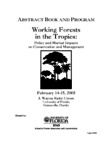Por favor, use este identificador para citar o enlazar este ítem:
http://www.alice.cnptia.embrapa.br/alice/handle/doc/503706Registro completo de metadatos
| Campo DC | Valor | Lengua/Idioma |
|---|---|---|
| dc.contributor.author | SERRANO, R. O. P. | pt_BR |
| dc.contributor.author | WADT, L. H. de O. | pt_BR |
| dc.contributor.author | KAINER, K. A. | pt_BR |
| dc.date.accessioned | 2011-04-10T11:11:11Z | pt_BR |
| dc.date.available | 2011-04-10T11:11:11Z | pt_BR |
| dc.date.created | 2006-03-16 | pt_BR |
| dc.date.issued | 2005 | pt_BR |
| dc.identifier.citation | In: WORKING FOREST IN THE TROPICS: policy and market impacts on conservation and management, 2005, Gainesville, Florida. Abstract book and program. Gainesville: University of Florida, 2005. | pt_BR |
| dc.identifier.uri | http://www.alice.cnptia.embrapa.br/alice/handle/doc/503706 | pt_BR |
| dc.description | In the Amazonian state of Acre, Brazil, Brazil nuts (Bertholletia excelsa H.B.K.) have been commercially collected for almost a century by traditional populations inhabiting the forests of the Acre River Valley. Brazil nut fruits fall to the ground in December through February when extractivists work almost exclusively in the collection and opening of these fruits to release the commercially valuable seeds or nuts. Based on income generated and labor utilized, this is the most important non-timber forest product activity in the state. Nonetheless, little is known about collection impacts on population structure. This study evaluated Brazil nut population structure in three traditional rubber tapper estates (sites) located in the municipalities of Xapuri and Brasiléia where the species occurs naturally: Filipinas, Cachoeira, and São Francisco Figueiredo. | pt_BR |
| dc.language.iso | eng | eng |
| dc.rights | openAccess | eng |
| dc.subject | Castanha do brasil | pt_BR |
| dc.subject | Vale do rio Acre | pt_BR |
| dc.subject | Acre River Valley | pt_BR |
| dc.subject | Nuez del Brasil | pt_BR |
| dc.subject | Dinámica poblacional | pt_BR |
| dc.subject | Seringal Filipinas | pt_BR |
| dc.subject | Seringal Cachoeira | pt_BR |
| dc.subject | Seringal São Francisco Figueiredo | pt_BR |
| dc.subject | Xapuri (AC) | pt_BR |
| dc.subject | Brasiléia (AC) | pt_BR |
| dc.subject | Amazonia Occidental | eng |
| dc.subject | Acre | eng |
| dc.subject | Amazônia Ocidental | eng |
| dc.subject | Western Amazon | eng |
| dc.title | Brazil nut population structure in thee sites in the Acre river valley, Brazil. | pt_BR |
| dc.type | Resumo em anais e proceedings | pt_BR |
| dc.date.updated | 2016-02-24T11:11:11Z | pt_BR |
| dc.subject.thesagro | Castanha do Para | pt_BR |
| dc.subject.thesagro | Bertholletia Excelsa | pt_BR |
| dc.subject.thesagro | Dinâmica Populacional | eng |
| dc.subject.nalthesaurus | Population dynamics | eng |
| dc.subject.nalthesaurus | Brazil nuts | eng |
| dc.format.extent2 | p. 111. | pt_BR |
| riaa.ainfo.id | 503706 | pt_BR |
| riaa.ainfo.lastupdate | 2016-02-24 | pt_BR |
| dc.contributor.institution | RODRIGO O. P. SERRANO, Embrapa Acre | pt_BR |
| dc.contributor.institution | LUCIA HELENA DE OLIVEIRA WADT, CPAF-AC | eng |
| dc.contributor.institution | KAREN A. KAINER, University of Florida. | eng |
| Aparece en las colecciones: | Resumo em anais de congresso (CPAF-AC)  | |
Ficheros en este ítem:
| Fichero | Descripción | Tamaño | Formato | |
|---|---|---|---|---|
| 12791.pdf | 140.39 kB | Adobe PDF |  Visualizar/Abrir |









